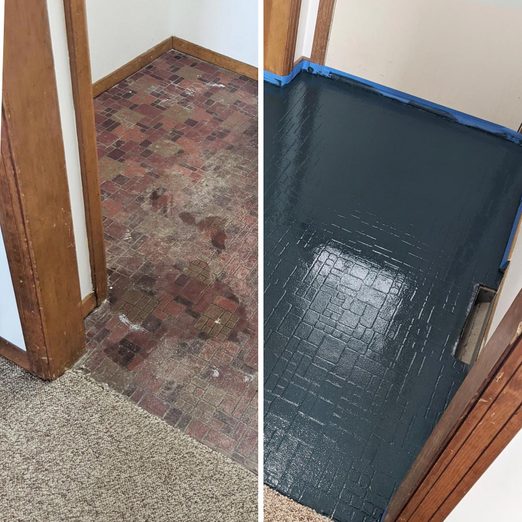To paint vinyl flooring, clean, sand, prime, and apply a vinyl-specific paint for best results. Painting vinyl floors can quickly transform the look of a room, offering a cost-effective alternative to replacement.
By following a few simple steps, you can achieve a fresh, new appearance for your vinyl flooring. Keep in mind the type of paint and primer you use, as well as proper ventilation during the painting process. With the right materials and techniques, you can update your vinyl flooring with a durable and stylish finish.
Let’s explore the steps involved in painting vinyl flooring to give your space a whole new look.

Credit: www.familyhandyman.com
Choosing The Right Paint
For painting vinyl flooring, it’s crucial to choose the right type of paint. Look for a high-quality, durable paint specifically designed for use on floors. Consider factors like color, finish, and adhesion to ensure the best results. Prep the surface thoroughly before applying the paint for a long-lasting finish.
Surface Preparation
Before you paint vinyl flooring, make sure to prepare the surface properly.
- Start by cleaning the floor with a mild detergent and water.
- Scuff sand the vinyl to help the paint adhere better.
- Use a deglosser to remove any existing shine and create a good base.
Primer And Paint Selection
Choosing the right primer and paint is crucial for a successful vinyl floor painting project.
- Opt for a high-quality bonding primer specifically designed for vinyl surfaces.
- Select acrylic paint that is durable and suitable for high-traffic areas.
- Consider using a porch and floor paint for best results.
- Ensure the paint is water-based for ease of application and quick drying.
Preparing The Vinyl Flooring
In the process of painting vinyl flooring, preparing the vinyl flooring is crucial for ensuring a successful paint job. This step involves cleaning and repairing any damage, as well as sanding and deglossing the surface to create a suitable base for the paint.
Cleaning And Repairing
- Clean the vinyl flooring with a mild detergent and water solution to remove any dirt or grime.
- Repair any cracks or chips in the flooring using a vinyl patching compound to ensure a smooth surface.
- Check for loose edges or corners and use adhesive to secure them in place before painting.
Sanding And Deglossing
- Use a fine-grit sandpaper to lightly sand the vinyl flooring, creating a rough surface for better paint adhesion.
- Degloss the flooring by applying a liquid deglosser to remove any shiny finish that may prevent the paint from adhering properly.
Application Techniques
When it comes to painting vinyl flooring, the application techniques play a crucial role in achieving a professional-looking and long-lasting finish. The right application method, whether using a roller or brush, and knowing how to apply multiple coats effectively can make all the difference in the final result.
Roller Vs. Brush
Deciding whether to use a roller or a brush for applying paint to your vinyl flooring is an important consideration. Rollers are great for covering large areas quickly and evenly. On the other hand, brushes are perfect for reaching corners and edges with precision. When painting vinyl flooring, a combination of both tools can provide the best results.
Applying Multiple Coats
Applying multiple coats of paint to your vinyl flooring is crucial for achieving a durable and aesthetically pleasing finish. Ensure that each coat is completely dry before applying the next one. This can help to prevent the paint from peeling or wearing off easily, providing a longer-lasting result.

Credit: www.homedepot.com
Finishing And Sealing
To paint vinyl flooring, ensure proper finishing and sealing for durability and longevity. Follow the steps meticulously to achieve a flawless, long-lasting painted floor finish. Proper finishing and sealing are crucial to ensure the paint adheres well and withstands wear and tear.
Once you have successfully painted your vinyl flooring, the next crucial step is to apply a sealant to ensure the longevity and durability of your newly transformed surface. In this section, we will discuss the key aspects of finishing and sealing your painted vinyl flooring, including how to choose the right sealant and proper curing and maintenance techniques.
Choosing A Sealant
When it comes to selecting a sealant for your painted vinyl flooring, it is important to choose a product that is specifically designed for this purpose. Look for a high-quality, water-based polyurethane sealant that provides exceptional adhesion and protection against everyday wear and tear. Ensure that the sealant is clear and non-yellowing, to maintain the vibrant appearance of your painted floor.
To make your decision easier, consider the following factors when choosing a sealant:
1. Durability: Opt for a sealant that offers long-lasting protection against scuffs, stains, and moisture.
2. Application: Select a sealant that is easy to apply and dries quickly, allowing you to enjoy your beautifully sealed floor in no time.
3. Compatibility: Make sure the sealant is suitable for use on vinyl flooring and does not cause any adverse reactions with the paint.
Curing And Maintenance
Proper curing and regular maintenance are essential to maximize the lifespan of your painted vinyl flooring. It is important to follow the manufacturer’s instructions for the specific sealant you have chosen. Generally, you should allow the sealant to cure for at least 24 hours before subjecting the floor to normal foot traffic.
To ensure the continued beauty and durability of your painted vinyl flooring, consider the following maintenance tips:
1. Cleaning: Regularly sweep or vacuum the floor to remove dirt and debris. Use a damp mop with a mild detergent to clean any spills or stains.
2. Protection: Place doormats at the entrances to your painted floor to minimize the amount of dirt and moisture that gets tracked onto the surface.
3. Avoid Harsh Chemicals: Refrain from using abrasive cleaners or harsh chemicals that can damage the sealant or vinyl flooring.
With proper finishing and sealing, as well as regular maintenance, your painted vinyl flooring will retain its beauty and provide years of enjoyment. Take the time to choose a suitable sealant and follow the recommended curing and maintenance procedures to ensure the success of your project.
Creative Design Ideas
Discover innovative ways to transform your space with creative design ideas for painting vinyl flooring. Elevate your interior with unique patterns and colors, bringing a personalized touch to your home decor. Explore the endless possibilities of revitalizing your floors with a fresh coat of paint.
Stenciling Patterns
Stenciling patterns can transform your vinyl flooring into a work of art. By using stencils, you can create intricate designs and patterns that add a unique touch to your space. Whether you want to create a vintage-inspired look or a modern geometric pattern, stenciling allows you to unleash your creativity. To get started, choose a stencil that complements your style and gather the necessary materials.
- First, clean and prepare your vinyl flooring surface by sweeping away any dust or debris.
- Secure the stencil on the desired area of the floor using painter’s tape to prevent it from shifting.
- Apply a thin layer of vinyl floor paint on the stencil, making sure not to overload it to avoid bleeding.
- Once you’ve filled in the stencil, carefully remove it to reveal your beautiful pattern.
- Allow the paint to dry completely before applying a clear sealant to protect your design.
Using Color Combinations
Color combinations can help you achieve the desired effect when painting vinyl flooring. Whether you want a bold and vibrant look or a subtle and calming atmosphere, selecting the right colors is crucial. Here are a few tips to help you choose the perfect color combinations for your vinyl floor:
- Consider the overall color palette of your room to ensure the flooring complements the rest of the space.
- For a contemporary feel, experiment with contrasting colors like black and white or gray and yellow.
- Use a monochromatic color scheme by selecting different shades of the same color for a sophisticated and cohesive look.
- Keep in mind that lighter colors can make a small room appear more spacious, while darker colors add depth and coziness.
- Play with patterns and textures by combining different shades of the same color for an interesting and dynamic floor design.
Frequently Asked Questions On How To Paint Vinyl Flooring
Can You Paint Vinyl Flooring?
Yes, you can paint vinyl flooring. However, it is important to properly prepare the surface by cleaning it and removing any dirt or grease. Use a primer designed for vinyl and apply multiple coats of high-quality floor paint for a long-lasting finish.
Finish with a clear sealant to protect the paint from wear and tear.
What Type Of Paint Should I Use For Vinyl Flooring?
For painting vinyl flooring, it is recommended to use a high-quality floor paint that is specifically designed for use on vinyl surfaces. Look for paints that are water-based, durable, and suitable for high traffic areas. Make sure to choose a color that complements your overall decor and style.
Do I Need To Prime Vinyl Flooring Before Painting?
Yes, priming the vinyl flooring is an essential step before painting. It helps to create a smooth and even surface, promotes better adhesion of the paint, and prevents the paint from peeling or chipping over time. Choose a primer that is specifically formulated for use on vinyl surfaces and follow the manufacturer’s instructions for application.
How Do I Prepare Vinyl Flooring For Painting?
Before painting vinyl flooring, start by thoroughly cleaning the surface using a mild detergent and warm water. Remove any existing wax or polish and ensure the floor is completely dry. Repair any cracks or damages with a suitable filler, then sand the surface lightly to create a better bond for the primer and paint.
Finally, clean the floor again to remove any dust or debris before priming and painting.
Conclusion
Painting vinyl flooring is an affordable and creative way to refresh your space. By following the proper preparation and painting techniques, you can achieve stunning results. Remember to choose high-quality paint and sealers to ensure durability. With the right tools and a little DIY spirit, you can transform your vinyl floors into a stylish focal point for your home.


